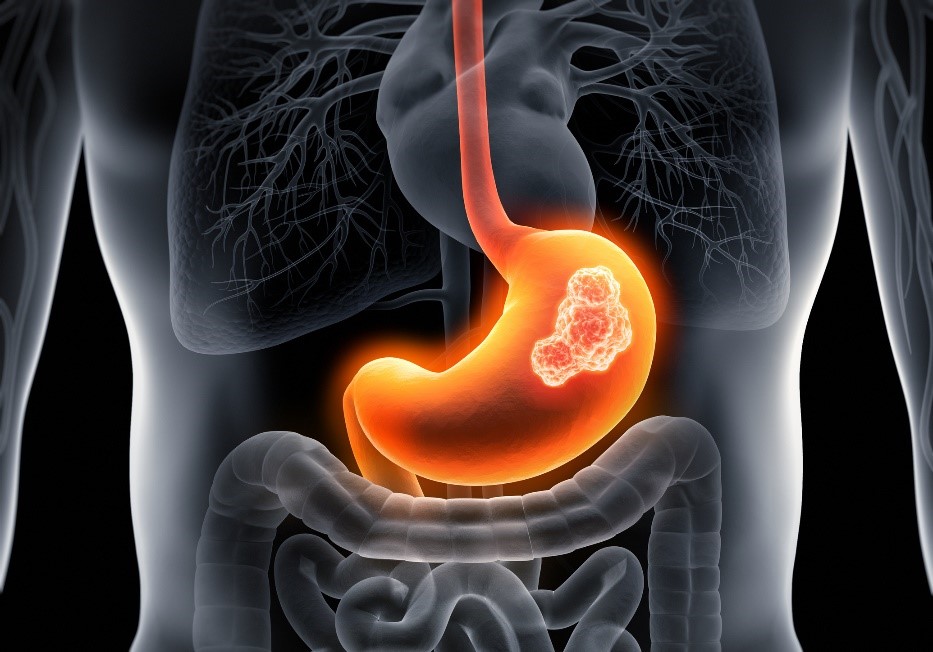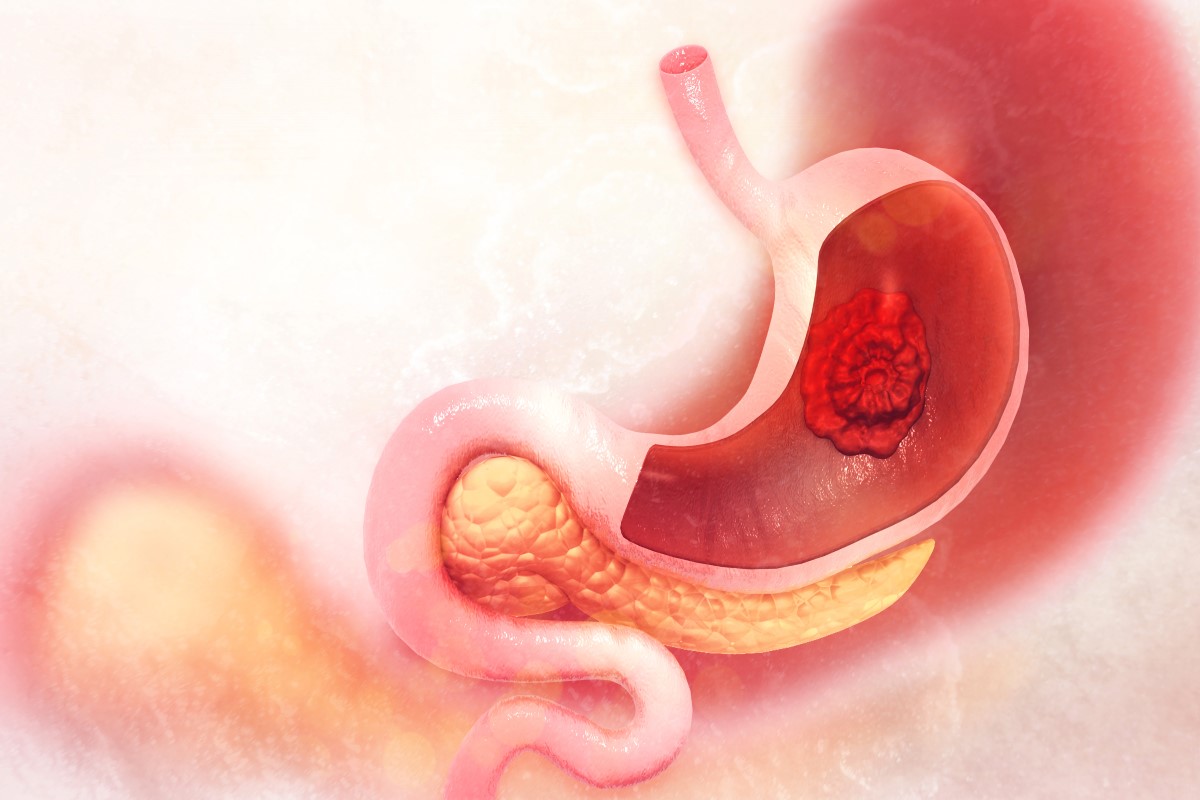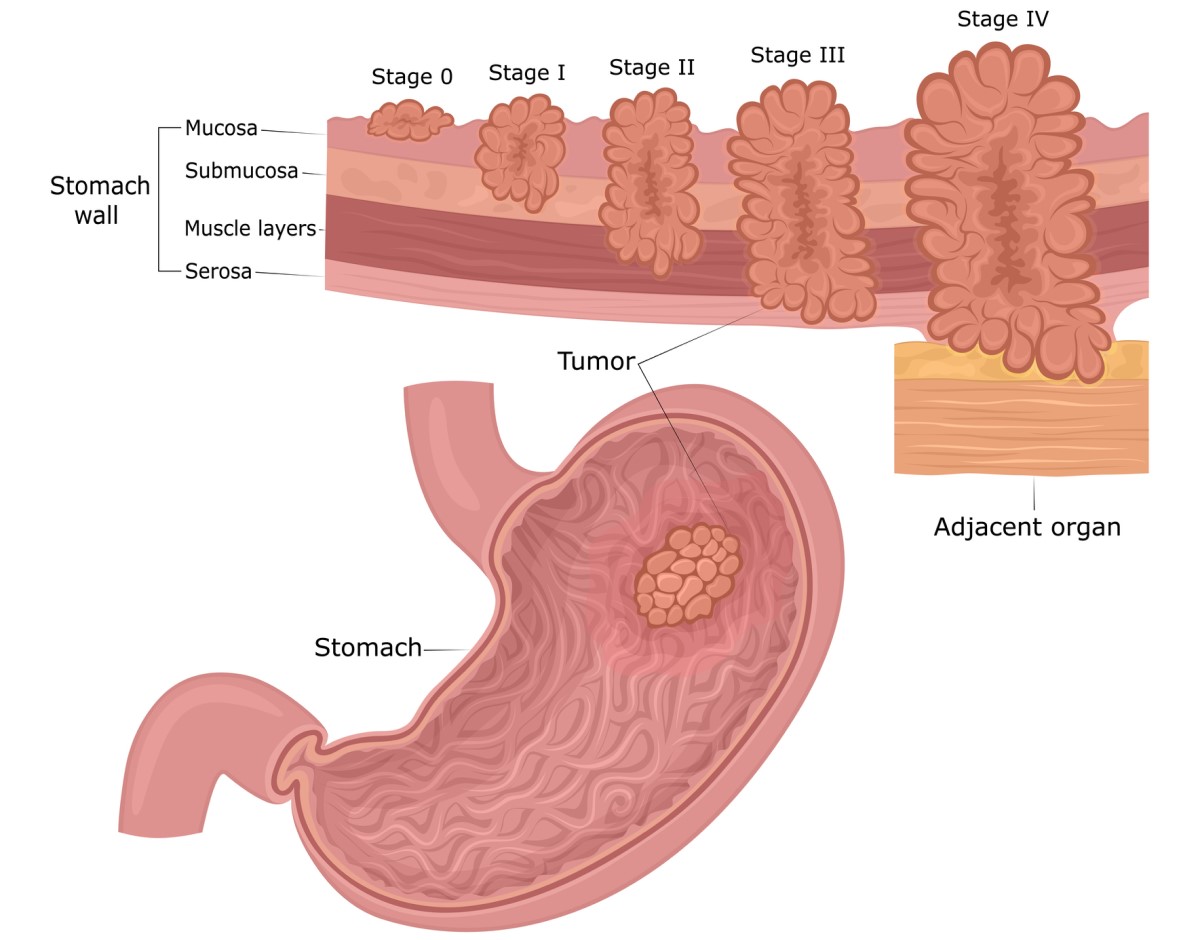- noisk.sk - Gastric cancer. AnticancerFund - ESMO/ACF Patient Guide
- solen.sk - Gastric cancer from the perspective of a gastroenterologist. Solen. Boris Pekárek, MD, PhD et al.
- healthline.com - Gastric cancer (adenocarcinoma of the stomach ). Healthline. Kristeen Cherney
- Onkologiecs.cz - Gastric cancer. Onkologiecs.cz - Tomáš Šálek
Stomach cancer: what are its causes, manifestations and first symptoms?

Gastric cancer is a cancer with a high mortality rate. What are its first symptoms and treatment options?
Most common symptoms
- Malaise
- Abdominal Pain
- Pain when swallowing
- Increased body temperature
- Nausea
- Thinning
- Black stool
- Sweating
- Indigestion
- The Island
- Swallowing disorders
- Stool with blood - blood in the stool
- Muscle weakness
- Fatigue
- Vomiting blood
- Enlarged lymph nodes
- Vomiting
Characteristics
Gastric cancer is a serious cancer with a high mortality rate. However, its incidence is slightly decreasing worldwide. A large proportion of patients are diagnosed at an advanced stage of the disease.
What are the first symptoms of stomach cancer? What are the treatment options?
Stomach cancer has the highest incidence in Japan, Chile or Central and South America. It is the second most common cause of cancer-related death. Adenocarcinoma (a malignant tumour arising from glandular epithelial cells) is the most common type of stomach cancer.
In this article, you will learn the causes, risk factors, symptoms, diagnosis, treatment options and many other interesting information.
The stomach in a nutshell
The stomach (gaster, stomachus) is a sac-shaped organ of the digestive tract. It connects the oesophagus and the small intestine. The main function of the stomach is to collect ingested food. Using peristaltic waves, together with gastric juice, it chemically converts the food into digested food (chyme). The food processed in this way gradually travels to the small intestine. In the small intestine, it is processed and absorbed into the body with the necessary substances and nutrients.
The stomach wall consists of 4 basic layers:
- the inner lining - the mucosa
- the submucosa - the submucosa
- the smooth muscle layer
- the outer layer - serosa
Gastric cancer
Gastric cancer occurs twice as often in men as in women. It is most often diagnosed between the ages of 60 and 80.
Adenocarcinoma is the most common type of gastric cancer. It arises from the pathological transformation of cells in the stomach lining. As it grows and develops, the disease can affect the entire stomach wall, lymph nodes, abdominal cavity and other surrounding and distant organs.
Currently, a distinction is made between intestinal and diffuse gastric tumours.
The intestinal type develops on the basis of a specific disease, most often atrophic gastritis and bacterial infection with Helicobacter pylori.
The diffuse type most often develops without previous disease. It is mainly due to genetic predisposition.
Other types of gastric cancer include:
- Lymphomas arising from cells of the immune system located in the wall of the stomach
- Gastrointestinal stromal tumours arising from cells in the stomach wall
- Neuroendocrine tumours arising from nerve or endocrine cells of the stomach
The diagnosis and treatment of these tumours is different from that of gastric adenocarcinomas.
Up to 80 % of patients with gastric cancer are diagnosed at an advanced stage of the disease. When the cancer reaches an advanced stage, mild and atypical health problems leading to early diagnosis can already be observed.

Causes
The development of stomach cancer is determined by many factors. Genetic and environmental factors play the biggest role.
Environmental factors include an inappropriate lifestyle, such as a diet high in salt and nitro compounds. This includes smoked and canned foods. Negative factors include alcohol, low intake of fibre, protein, vegetables and fruit.
Smoking significantly increases the risk of stomach and digestive tract cancer.
Working in the presence of ionizing radiation and asbestos increases the risk of developing the disease.
The presence of infections and inflammatory processes in the digestive tract is a risk factor. Bacterial infections Helicobacter pylori, Epstein-Barr virus, atrophic gastritis and conditions following gastric surgery.
Helicobacter pylori is considered an important risk factor for carcinogenesis in gastric adenocarcinoma and non-Hodgkin's lymphomas of the stomach.
Gastric polyps are benign growths of the gastric mucosa. One type of polyp (adenoma) can develop into cancer. Gastroesophageal reflux increases the risk of cancer in the oesophagogastric junction. Treatment and prevention by a gastroenterologist is therefore always essential.
A single inherited mutation in the CDH1 gene encoding the E-cadherin protein leads to a high risk of diffuse gastric cancer.
This genetic factor is also linked to Lynch syndrome (HNPCC - Hereditary Non Polyposis Colorectal Cancer), which is caused by damage to the repair genes. It poses a risk of developing other cancers.
Some other inherited mutations that cause cancer in other parts of the body can also increase the risk of stomach cancer. Examples are mutations that increase the risk of colon cancer and familial adenomatous polyposis.
A risk factor is a family history of stomach cancer in first-degree relatives (parents, siblings and children).

Symptoms
Stomach cancer does not show significant clinical symptoms in the early stages. Initial symptoms are quite common and may also indicate other diseases. Weak appetite, feeling full after finishing a meal despite a small portion, discomfort or pain in the abdomen.
The first significant symptoms usually do not appear until the individual is in a more advanced stage. Stomach and abdominal pain are present. Patients report loss of appetite, nausea, vomiting, excessive fatigue and general weakness.
The first symptoms may last for several months. If the carcinoma is located in the upper part of the stomach, difficulty swallowing may occur. Swelling and fluid accumulation in the abdomen may be noted.
At a later stage of development, vomiting and possibly vomiting with blood may occur. A reported symptom of stomach cancer is the presence of blood in the stool, black to tarry stools.
Manifestations and symptoms of stomach cancer:
- Stomach pain
- Pain in the epigastric region (epigastrium)
- Loss of appetite
- Feeling full after a small portion
- Nausea
- Fatigue and weakness
- Weight loss
- Vomiting
- Vomiting with admixture of blood
- Black tarry stools
- Presence of blood in the stool
- Fluid accumulation (swelling) in the abdominal cavity
Due to the growth and development of carcinoma, the disease is divided into 4-5 stages.
Stage 0: Abnormally infected cells are found in the inner layer of the stomach lining.
Stage I: The carcinoma grows into the inner layer of the mucosa, affecting the nearby muscle layer and eventually the serosa layer of the stomach. However, the lymph nodes are not affected.
Stage II: The carcinoma affects the deeper walls of the stomach and a varying number of the lymph nodes involved. Both the muscle layer and the deep serosa of the stomach are affected.
Stage III: The tumour has spread to the muscle layer, the subserosa and up to 15 lymph nodes. Alternatively, the disease has affected the structures surrounding the stomach. However, the carcinoma has not spread to distant organs and other parts of the body (liver, lungs...).
Stage IV: At this stage, more than 15 lymph nodes are affected. The cancer has spread to the structures surrounding the stomach or to distant organs and parts of the body. Metastases are present at this stage.

Diagnostics
Up to 80% of patients with stomach cancer are diagnosed at an advanced stage of the disease.
By the time the cancer reaches an advanced stage, mild and atypical health problems can be observed leading to early diagnosis.
Diagnosis is also based on the patient's clinical symptoms such as weight loss, pain in the epigastrium and bleeding from the digestive tube. This is already an advanced stage of cancer.
The first main investigation is an endoscopic examination (gastroscopy). Gastroscopy allows for the collection of a biopsy of the tissue and subsequent histological laboratory examination to determine the exact type of gastric cancer.
Histopathological analysis will confirm the diagnosis of cancer and provide further information about the type, nature and type of tumour.
The examining physician inserts a special flexible tube (endoscope) through the neck into the patient's stomach. During the examination, an endoscopic ultrasound may be performed at the same time, during which the ultrasound probe provides an image of the different layers of the stomach wall and surrounding area.
Computed tomography (CT) and PET are used to assess surrounding metastases and classify the stage of the tumour.
Currently, virtual CT gastrography can be used. It is particularly useful in the differential diagnosis between early stage gastric cancer and gastritis.
The most commonly used classification is the TMN classification, which together with histological examination provides the basic treatment plan. The depth of tumour penetration (T), lymph node involvement (N) and the presence of distant metastases (M) are assessed.
In some cases, diagnostic laparoscopy is chosen to assess abdominal peritoneal dissemination and spread of the disease.
Course
The progression of stomach cancer is subtle in the early stages and difficulties may not be present. Only common health problems may occur, as with other diseases of the digestive tract. More serious and pronounced symptoms only appear at a more advanced stage. Symptoms are described in the Symptoms section.
Prevention of stomach cancer
Genetic factors alone do not prevent cancer. However, it is possible to eliminate the risk of stomach cancer by external environmental factors.
A complete balanced diet containing sufficient fibre, vitamins A, C and D, beta-carotene and selenium is essential. Vegetables and fruits are protective. Root and brassica vegetables (broccoli, cabbage, carrots, etc.), berries, cereals, nuts, legumes, turmeric, green tea and others are good choices.
On the other hand, salted and smoked foods that irritate the stomach lining are a risk factor. High intake of foods containing nitrates and nitrites, such as canned meats, can adversely affect the risk of stomach cancer.
Smoking, alcohol and drug consumption are strong risk factors.
It is advisable to seek medical advice in case of problems and unclear symptoms. In case of Helicobacter pylori infection (including other infections in the body), antibiotic and supportive professional treatment should be started as soon as possible.
Regular preventive check-ups with a general practitioner and a gastrointestinologist are recommended. Preventive oncomarker testing of the patient's blood sample is recommended. Oncomarkers are substances present in the body as a result of the development of malignant disease produced by cancer cells.
Prevention of digestive tract cancer:
- A regular balanced diet
- Adequate intake of protein in the diet
- Adequate dietary fibre intake
- Adequate consumption of fruits and vegetables
- Intake of necessary vitamins and minerals
- Sufficient compensatory physical activity
- Quit smoking tobacco products
- Stop consuming alcohol
- Elimination of foods high in salt
- Eliminate foods high in nitrates
- Early initiation of antibiotic treatment for infection
- Taking prebiotics and probiotics after overcoming the infection
- Regular preventive check-ups with a doctor

How it is treated: Cancer of the stomach
Treatment of stomach cancer: surgery, stomach removal, radio/chemotherapy
Show moreThe origin and development of stomach cancer
Other names
Interesting resources










